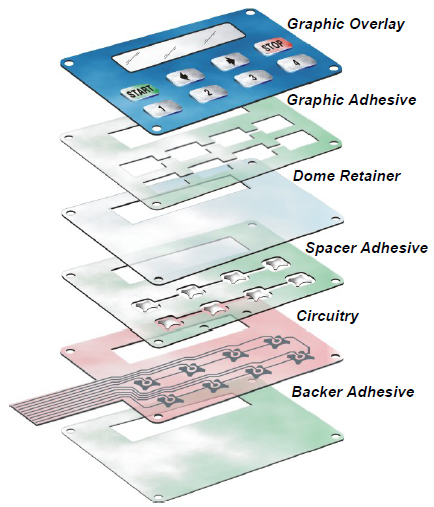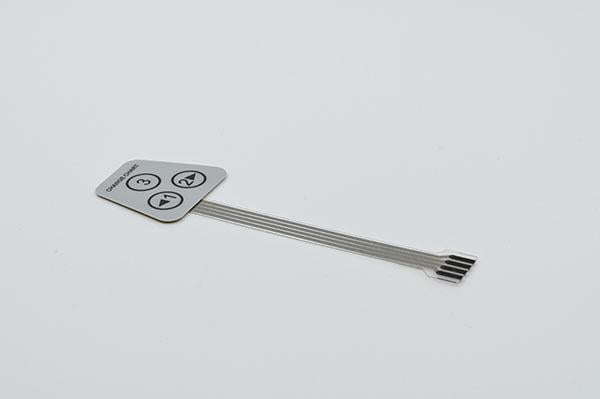Choosing the right membrane switch manufacturer can significantly impact your product's performance.
All About Membrane Layer Change: Comprehending Its Design and Capability
When you believe about the control user interfaces in modern gadgets, membrane layer buttons typically enter your mind. These components are more than simply buttons; they mix layout and performance effortlessly. Recognizing how they work and what makes them effective can alter your viewpoint on daily electronics. There are subtleties to their style and performance that you could not be conscious of. Let's discover what collections membrane layer switches aside from various other control systems.
What Are Membrane Layer Switches?

Their seamless nature makes them simple to tidy and immune to dirt and dampness, a vital attribute in lots of environments. Membrane layer switches can also be tailored regarding form, size, and graphics, permitting makers to develop one-of-a-kind user interfaces customized to certain items. And also, they're light-weight and thin, which assists in lessening the total mass of gadgets. In general, membrane buttons play a substantial role in boosting customer experience across a broad variety of applications.
Exactly How Membrane Switches Over Job
When you push a key on a membrane switch, it turns on an uncomplicated yet efficient mechanism. membrane switch manufacturer. The top layer, frequently made of flexible material, pushes down onto a conductive layer under it.
You'll notice that the responsive responses varies based upon the button style, providing either a soft click or a much more pronounced reaction. As soon as you launch the trick, the membrane returns to its initial placement, resuming the circuit and stopping the signal. This procedure occurs nearly instantaneously, guaranteeing a receptive user experience.
Membrane layer buttons are preferred due to their longevity and resistance to dirt and moisture, making them perfect for different applications, from house appliances to medical gadgets. Comprehending this operation helps you value their widespread usage.
Secret Components of Membrane Switches
Comprehending the crucial parts of membrane switches is fundamental for realizing their functionality and design. At the core, you'll locate the graphic overlay, which gives the visual user interface for customers. Below that, there's a spacer layer that separates the circuit layers, making certain that they don't make call until pushed. The circuit layer is where the magic takes place; it includes conductive traces that finish the circuit when you push the switch. Another important element is the glue backing, enabling the switch to comply with surface areas firmly. Lastly, the protective layer shields against environmental factors and use, prolonging the button's life expectancy. Each element plays a significant role in ensuring dependable performance and user interaction. By understanding these elements, you'll get understanding right into exactly how membrane changes operate and their value in different applications.
Products Utilized in Membrane Switch Design
The efficiency and longevity of membrane switches over heavily depend on the materials used in their layout. You typically run into polyester and polycarbonate as main substratums visit this site as a result of their superb toughness and versatility. These products withstand scratches and chemicals, making them optimal for requiring atmospheres.
The conductive layers usually use silver or carbon, selected for their integrity and conductivity. membrane switch manufacturer. Silver provides premium performance, while carbon is an economical alternative. For the overlay, you could think about a matte or glossy surface, depending upon your aesthetic needs and customer experience
Make particular to select adhesives that endure environmental aspects like temperature level and moisture. Choosing the right materials will ensure your membrane layer button stands the examination of time.
Layout Factors To Consider for Membrane Layer Buttons
While designing membrane buttons, it's vital to take into consideration different aspects that influence their performance and user experience. Start by concentrating on the design and switch dimension; make sure they're user-friendly and easy to navigate. Consider the responsive comments you desire to provide-- will users need a visible click or a softer touch? Furthermore, believe concerning the products you'll utilize, as they'll affect resilience and looks.
Don't ignore the graphic style; clear labeling and shade contrast are considerable for presence. Verify your layout accommodates environmental elements, like wetness or temperature level variants, which could impact performance. Finally, keep in mind the importance of screening models with genuine customers to gather responses and make required adjustments. This repetitive procedure helps you refine the style, verifying it meets both practical and aesthetic needs efficiently. By carefully taking into consideration these elements, you'll develop a membrane switch that improves use and complete satisfaction.
Applications of Membrane Layer Switches
Membrane layer buttons are versatile elements found in different applications, from industrial equipment to customer electronic devices. You'll see their effect in makers that need long lasting user interfaces and in gadgets that benefit from streamlined layouts. Understanding these applications helps you value the functionality and functionality of membrane switches in daily technology.
Industrial Equipment Usage
When you're looking to improve the capability of commercial devices, membrane buttons use a dependable option that combines durability with user-friendly layout. These buttons are excellent for severe settings, offering resistance to dirt, look here dampness, and chemicals. Welcome membrane switches to streamline your procedures and improve total performance.
Customer Electronic Devices Integration
In the domain of consumer electronics, membrane layer buttons play a necessary function in improving user communication and gadget functionality. Membrane layer switches additionally ensure durability and resistance to dust and moisture, prolonging the lifespan of your electronic devices. By picking membrane switches, you improve not simply the performance however also the style of your gadgets, making day-to-day interactions smooth and satisfying.
Advantages and Downsides of Membrane Switches
While membrane layer buttons provide a variety of advantages, they additionally come with some downsides that you must think about. One substantial benefit is their small style, making them perfect for space-constrained applications.

However, there are downsides. Membrane layer buttons can have a much shorter life expectancy compared to mechanical buttons, specifically under hefty usage. They can additionally be less tactile, which may affect customer feedback during procedure. If harmed, repairing them can be difficult and typically requires full replacement. Eventually, their level of sensitivity to severe temperatures and environmental problems may limit their effectiveness in particular setups. Stabilizing these pros and disadvantages will certainly aid you figure out if membrane layer switches are the best suitable for your project.
Often Asked Questions
The Length Of Time Do Membrane Layer Changes Generally Last?
Membrane switches generally last in between 5 to ten years, relying on use and ecological conditions. You'll intend to assess variables like wear, direct exposure to dampness, and temperature level changes to evaluate their long life see this here efficiently.
Can Membrane Switches Over Be Customized for Certain Designs?
Yes, you can personalize membrane layer switches to fit specific layouts (membrane switch manufacturer). You'll have the freedom to select shades, forms, and formats that match your job's needs, ensuring they blend flawlessly with your general visual
What Is the Price Range for Membrane Switch Over Manufacturing?
The expense array for membrane switch production normally falls in between $1 and $10 per system, relying on elements like style complexity, amount, and materials. You can obtain quotes from manufacturers to discover the very best alternative.

Are Membrane Layer Switches Over Waterproof or Resistant?
Membrane switches can be created to be water-proof or immune, relying on products utilized and building and construction methods. If you need them for damp settings, ensure you specify those requirements throughout the design procedure.
How Do Membrane Layer Switches Over Compare to Typical Buttons?
Membrane layer switches are generally thinner and much more adaptable than conventional switches, supplying a streamlined layout. They're often easier to cleanse and integrate, however might not offer the tactile responses you're used to with mechanical options.
Verdict
